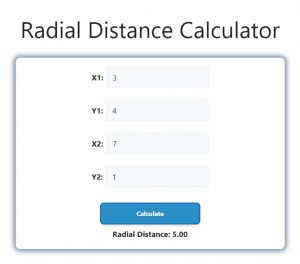About Radial Distance Calculator (Formula)
A Radial Distance Calculator is a useful tool for determining the distance between two points in a two-dimensional space. This calculation is crucial in various fields such as physics, engineering, and computer graphics. By understanding the radial distance, you can analyze movement, plot graphs, and understand spatial relationships effectively.
Formula
The formula to calculate radial distance is:
Drad = √((X2 – X1)^2 + (Y2 – Y1)^2)
Where:
- Drad is the radial distance.
- (X1, Y1) and (X2, Y2) are the coordinates of the two points in the Cartesian plane.
How to Use
- Identify Coordinates: Determine the coordinates of the two points whose distance you want to calculate. The points will be represented as (X1, Y1) and (X2, Y2).
- Input Values: Enter the X and Y coordinates into the calculator in their respective fields.
- Calculate Distance: Click the “Calculate” button to find the radial distance between the two points based on the entered coordinates.
Example
Suppose you want to calculate the radial distance between the points (3, 4) and (7, 1).
- Identify Coordinates:
X1 = 3, Y1 = 4
X2 = 7, Y2 = 1 - Plug into Formula:
Drad = √((7 – 3)^2 + (1 – 4)^2)
Drad = √((4)^2 + (-3)^2)
Drad = √(16 + 9)
Drad = √25
Drad = 5
The radial distance between the points (3, 4) and (7, 1) is 5 units.

FAQs
- What is radial distance?
Radial distance is the straight-line distance between two points in a two-dimensional space. - How is radial distance calculated?
It is calculated using the formula Drad = √((X2 – X1)^2 + (Y2 – Y1)^2). - What are the units of radial distance?
The units are typically in meters, kilometers, or any other measurement of distance, depending on the context. - Can radial distance be negative?
No, radial distance is always a positive value, as it represents the magnitude of distance. - What are common applications of a radial distance calculator?
It is used in fields like physics, engineering, navigation, and computer graphics. - Can I use this calculator for three-dimensional space?
No, this specific calculator is designed for two-dimensional space. For three dimensions, you would need a different formula. - How does the formula account for negative coordinates?
The formula involves squaring the differences, which eliminates negative values, ensuring the result is always positive. - What happens if the two points are the same?
If both points are the same, the radial distance will be zero. - Is it possible to calculate radial distance using geographic coordinates?
Yes, but for geographic coordinates (latitude and longitude), a different formula is typically used to account for the Earth’s curvature. - What if I only know one coordinate?
You need both coordinates to calculate radial distance. If one coordinate is unknown, the distance cannot be determined. - Can I use this calculator for graphing applications?
Yes, radial distance calculations are often used in graphing to determine distances between plotted points. - What is the significance of radial distance in physics?
Radial distance can be important in physics when analyzing forces, trajectories, and movement in a two-dimensional plane. - How can I verify my radial distance calculation?
You can verify your calculation by plotting the points on a graph and measuring the distance directly with a ruler or using graphing software. - Is there a difference between radial distance and Euclidean distance?
No, radial distance and Euclidean distance refer to the same concept when measuring distance in a two-dimensional Cartesian coordinate system. - What is the difference between radial distance and arc length?
Radial distance is a straight line between two points, while arc length measures the distance along a curve between two points. - Can the radial distance be used in navigation?
Yes, radial distance is useful in navigation for calculating the distance between waypoints on a map. - What tools can I use to calculate radial distance?
You can use calculators, graphing software, or programming languages that support mathematical functions. - Are there online tools available for calculating radial distance?
Yes, many online calculators can compute radial distance easily. - Can the radial distance calculation be applied in robotics?
Yes, radial distance calculations are often used in robotics for pathfinding and spatial awareness. - How does the distance change as the coordinates are altered?
The distance will change based on the position of the points; moving them closer together will reduce the distance, while moving them further apart will increase it.
Conclusion
The Radial Distance Calculator is an essential tool for calculating the straight-line distance between two points in a two-dimensional space. By using the formula Drad = √((X2 – X1)^2 + (Y2 – Y1)^2), users can easily determine distances needed for various applications in science, engineering, and beyond. Understanding and calculating radial distance is fundamental to analyzing spatial relationships, facilitating better decision-making and problem-solving in diverse fields.